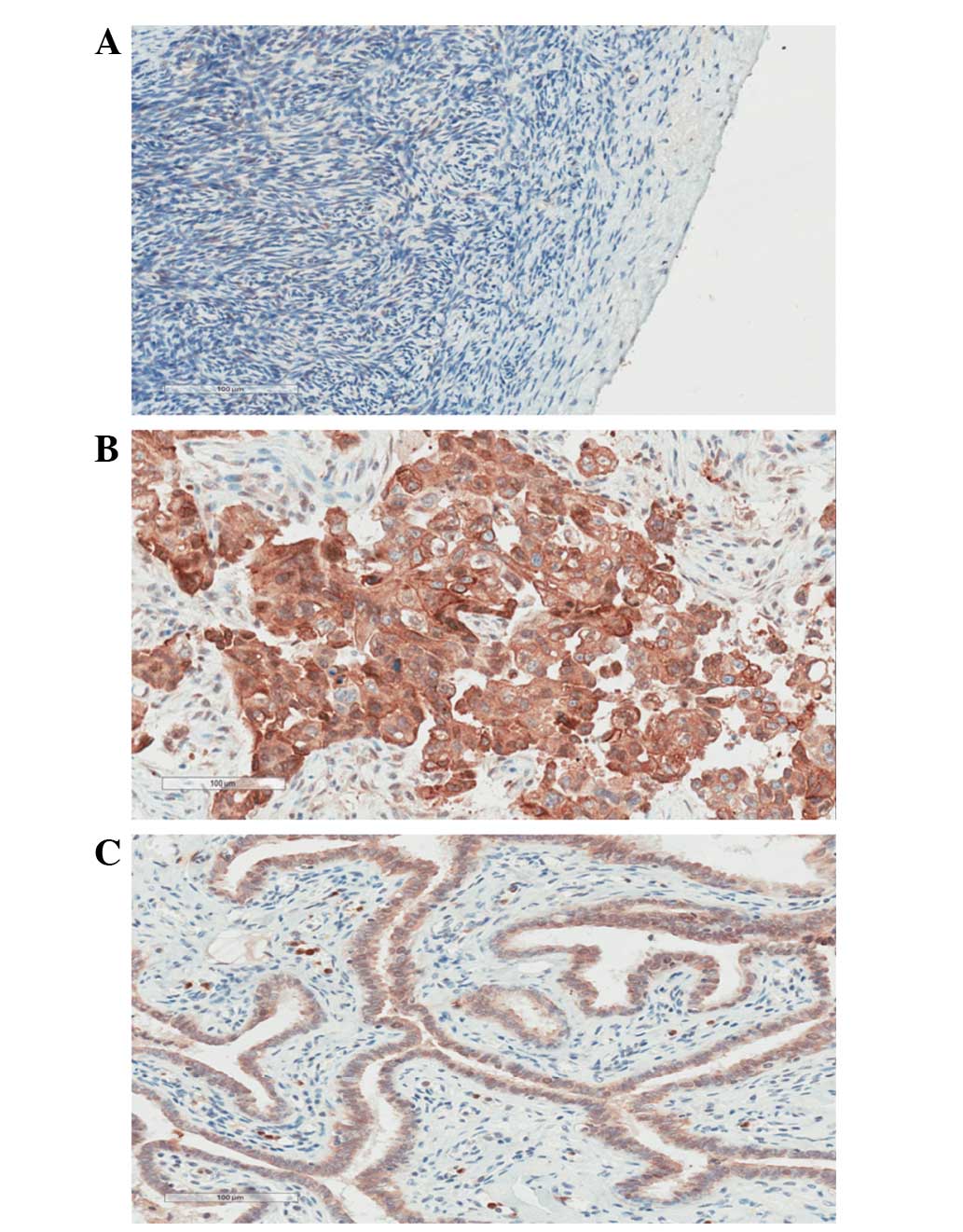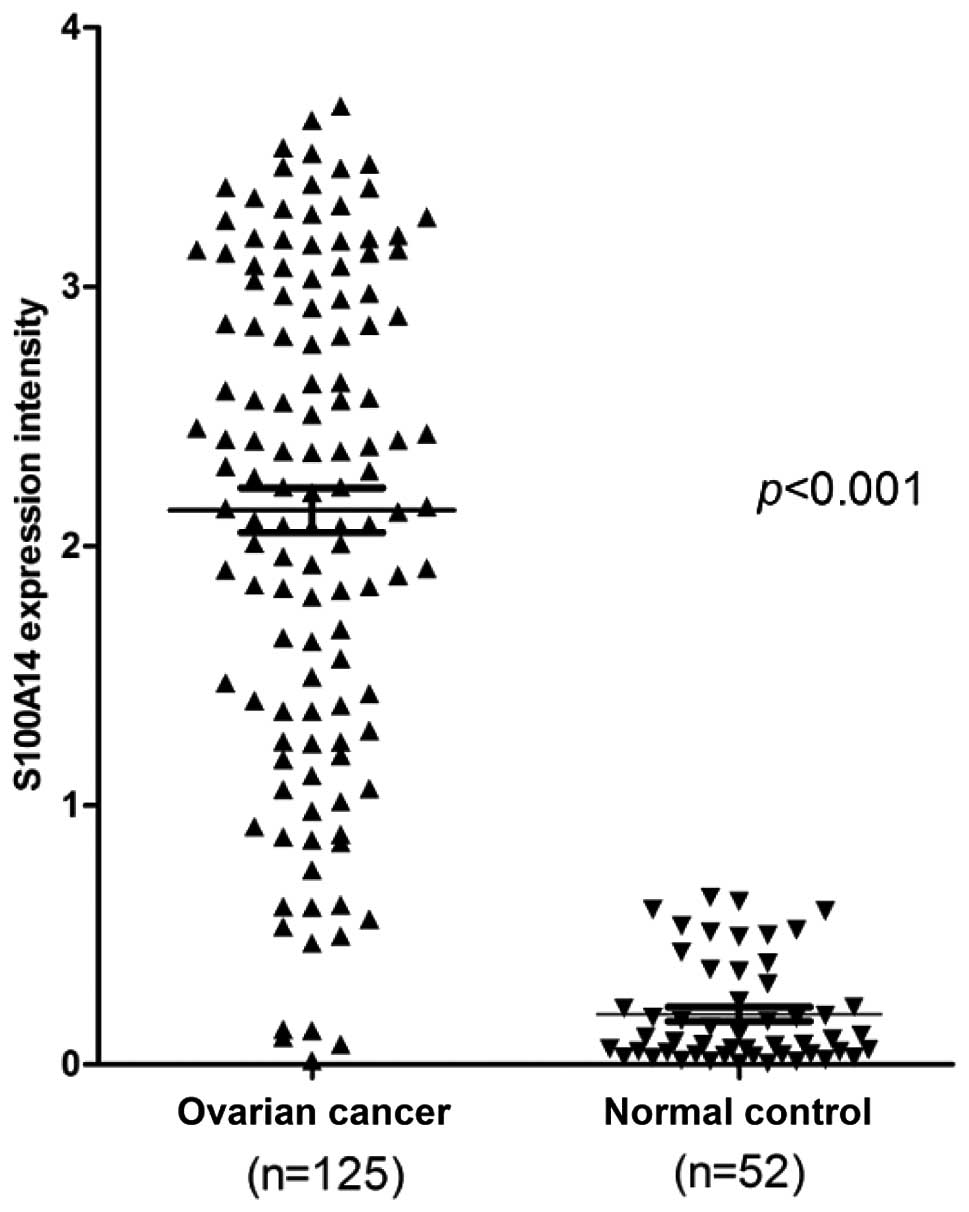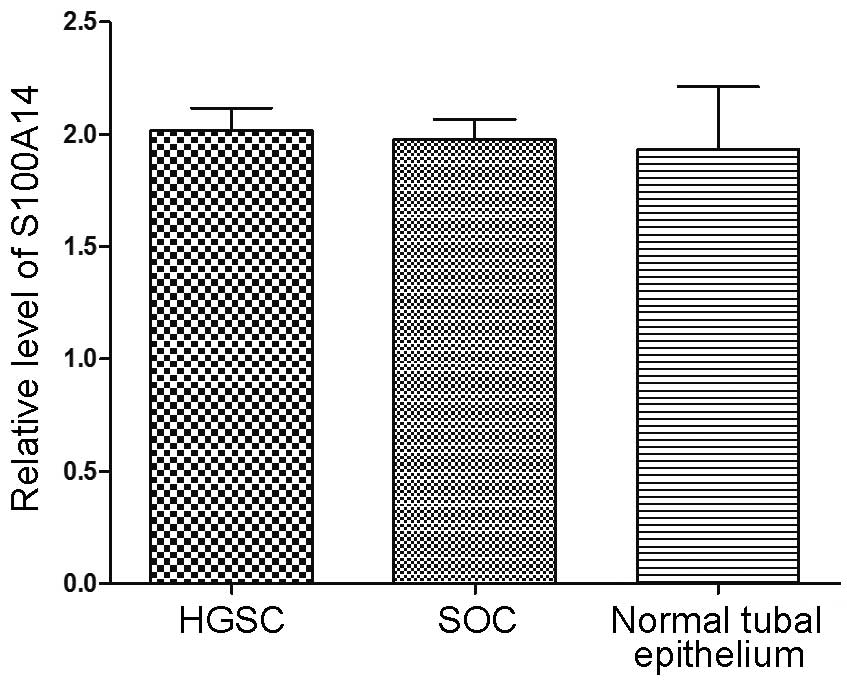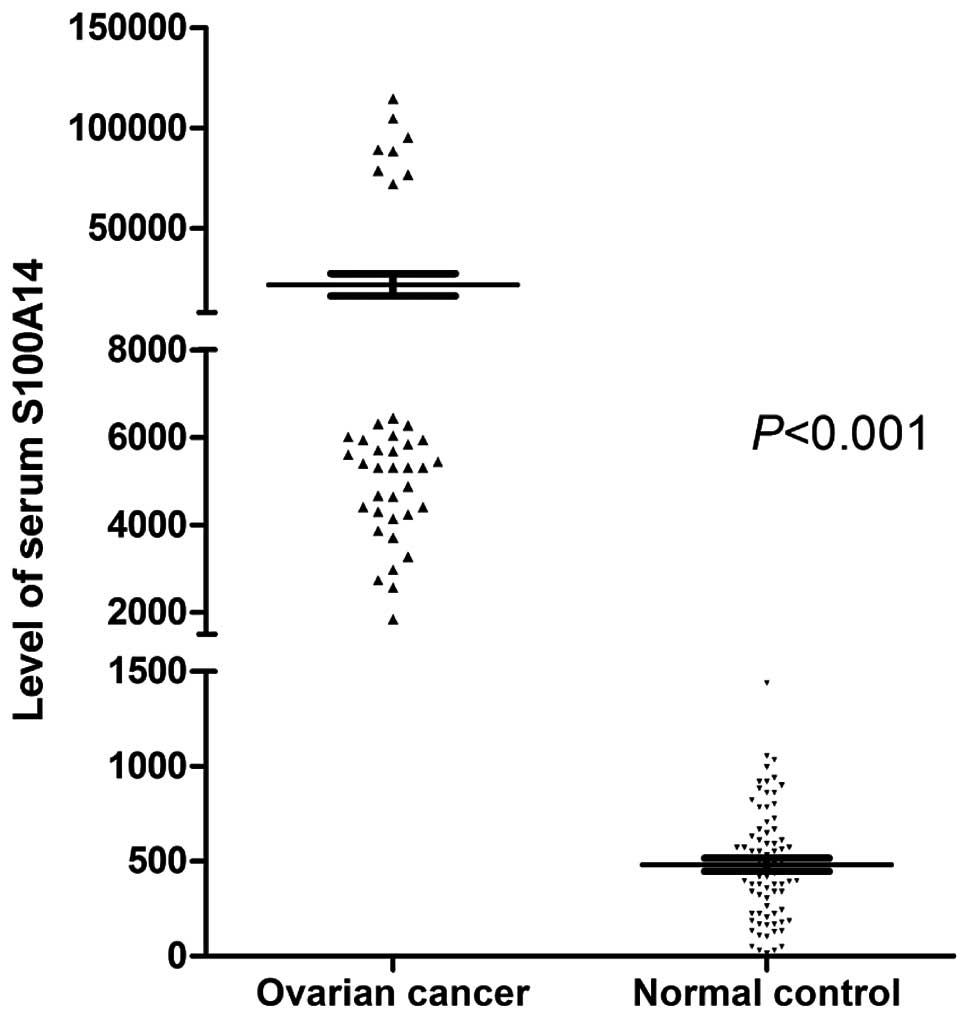|
1
|
Singh AP, Senapati S, Ponnusamy MP, et al:
Clinical potential of mucins in diagnosis, prognosis and therapy of
ovarian cancer. Lancet Oncol. 9:1076–1085. 2008. View Article : Google Scholar : PubMed/NCBI
|
|
2
|
Lin KT, Yeh YM, Chuang CM, Yang SY, Chang
JW, Sun SP, Wang YS, Chao KC and Wang LH: Glucocorticoids mediate
induction of microRNA-708 to suppress ovarian cancer metastasis
through targeting Rap1B. Nat Commun. 6:59172015. View Article : Google Scholar : PubMed/NCBI
|
|
3
|
Siegel R, Ma J, Zou Z and Jemal A: Cancer
statistics, 2014. CA Cancer J Clin. 64:9–29. 2014. View Article : Google Scholar : PubMed/NCBI
|
|
4
|
Chen W, Zheng R, Zhang S, Zhao P, Li G, Wu
L and He J: The incidences and mortalities of major cancers in
China, 2009. Chin J Cancer. 32:106–112. 2013. View Article : Google Scholar : PubMed/NCBI
|
|
5
|
Chen W, Zheng R, Zhang S, Zhao P, Li G, Wu
L and He J: Report of incidence and mortality in China cancer
registries, 2009. Chin J Cancer Res. 25:10–21. 2013.PubMed/NCBI
|
|
6
|
Gubbels JA, Claussen N, Kapur AK, Connor
JP and Patankar MS: The detection, treatment, and biology of
epithelial ovarian cancer. J Ovarian Res. 3:82010. View Article : Google Scholar : PubMed/NCBI
|
|
7
|
Schummer M, Ng WV, Bumgarner RE, Nelson
PS, Schummer B, Bednarski DW, Hassell L, Baldwin RL, Karlan BY and
Hood L: Comparative hybridization of an array of 21,500 ovarian
cDNAs for the discovery of genes overexpressed in ovarian
carcinomas. Gene. 238:375–385. 1999. View Article : Google Scholar : PubMed/NCBI
|
|
8
|
Eisenhauer EL, Abu-Rustum NR, Sonoda Y,
Aghajanian C, Barakat RR and Chi DS: The effect of maximal surgical
cytoreduction on sensitivity to platinum-taxane chemotherapy and
subsequent survival in patients with advanced ovarian cancer.
Gynecol Oncol. 108:276–281. 2008. View Article : Google Scholar : PubMed/NCBI
|
|
9
|
Barger CJ, Zhang W, Hillman J, Stablewski
AB, Higgins MJ, Vanderhyden BC, Odunsi K and Karpf AR: Genetic
determinants of FOXM1 overexpression in epithelial ovarian cancer
and functional contribution to cell cycle progression. Oncotarget.
6:27613–27627. 2015. View Article : Google Scholar : PubMed/NCBI
|
|
10
|
Singer G, Kurman RJ, Chang HW, Cho SK and
Shih IeM: Diverse tumorigenic pathways in ovarian serous carcinoma.
Am J Pathol. 160:1223–1228. 2002. View Article : Google Scholar : PubMed/NCBI
|
|
11
|
Kuhn E, Kurman RJ, Vang R, Sehdev AS, Han
G, Soslow R, Wang TL and Shih IeM: TP53 mutations in serous tubal
intraepithelial carcinoma and concurrent pelvic high-grade serous
carcinoma-evidence supporting the clonal relationship of the two
lesions. J Pathol. 226:421–426. 2012. View Article : Google Scholar : PubMed/NCBI
|
|
12
|
Heizmann CW, Fritz G and Schäfer BW: S100
proteins Structure, functions and pathology. Front Biosci.
7:d1356–d1368. 2002. View
Article : Google Scholar : PubMed/NCBI
|
|
13
|
Schäfer BW, Wicki R, Engelkamp D, Mattei
MG and Heizmann CW: Isolation of a YAC clone covering a cluster of
nine S100 genes on human chromosome 1q21: Rationale for a new
nomenclature of the S100 calcium-binding protein family. Genomics.
25:638–643. 1995. View Article : Google Scholar : PubMed/NCBI
|
|
14
|
Weterman MA, Wilbrink M and Dijkhuizen T:
van denB erg E and Geurts van Kessel A: Fine mapping of the 1q21
breakpoint of the papillary renal cell carcinoma-associated (X;1)
translocation. Hum Genet. 98:16–21. 1996. View Article : Google Scholar : PubMed/NCBI
|
|
15
|
Gendler SJ, Cohen EP, Craston A, Duhig T,
Johnstone G and Barnes D: The locus of the polymorphic epithelial
mucin (PEM) tumour antigen on chromosome 1q21 shows a high
frequency of alteration in primary human breast tumours. Int J
Cancer. 45:431–435. 1990. View Article : Google Scholar : PubMed/NCBI
|
|
16
|
Bresnick AR, Weber DJ and Zimmer DB: S100
proteins in cancer. Nat Rev Cancer. 15:96–109. 2015. View Article : Google Scholar : PubMed/NCBI
|
|
17
|
Huttunen HJ, Kuja-Panula J, Sorci G,
Agneletti AL, Donato R and Rauvala H: Coregulation of neurite
outgrowth and cell survival by amphoterin and S100 proteins through
receptor for advanced glycation end products (RAGE) activation. J
Biol Chem. 275:40096–40105. 2000. View Article : Google Scholar : PubMed/NCBI
|
|
18
|
Filipek A, Jastrzebska B, Nowotny M and
Kuznicki J: CacyBP/SIP, a calcyclin and Siah-1-interacting protein,
binds EF-hand proteins of the S100 family. J Biol Chem.
277:28848–28852. 2002. View Article : Google Scholar : PubMed/NCBI
|
|
19
|
Arumugam T, Simeone DM, Schmidt AM and
Logsdon CD: S100P stimulates cell proliferation and survival via
receptor for activated glycation end products (RAGE). J Biol Chem.
279:5059–5065. 2004. View Article : Google Scholar : PubMed/NCBI
|
|
20
|
Fernandez-Fernandez MR, Veprintsev DB and
Fersht AR: Proteins of the S100 family regulate the oligomerization
of p53 tumor suppressor. Proc Natl Acad Sci USA. 102:4735–4740.
2005. View Article : Google Scholar : PubMed/NCBI
|
|
21
|
Zhang HY, Zheng XZ, Wang XH, Xuan XY, Wang
F and Li SS: S100A4 mediated cell invasion and metastasis of
esophageal squamous cell carcinoma via the regulation of MMP-2 and
E-cadherin activity. Mol Biol Rep. 39:199–208. 2012. View Article : Google Scholar : PubMed/NCBI
|
|
22
|
Donato R: S100: A multigenic family of
calcium-modulated proteins of the EF-hand type with intracellular
and extracellular functional roles. Int J Biochem Cell Biol.
33:637–668. 2001. View Article : Google Scholar : PubMed/NCBI
|
|
23
|
Zimmer DB, Cornwall EH, Landar A and Song
W: The S100 protein family, History, function and expression. Brain
Res Bull. 37:417–429. 1995. View Article : Google Scholar : PubMed/NCBI
|
|
24
|
Pietas A, Schlüns K, Marenholz I, Schafer
BW, Heizmann CW and Petersen I: Molecular cloning and
characterization of the human S100A14 gene encoding a novel member
of the S100 family. Genomics. 79:513–522. 2002. View Article : Google Scholar : PubMed/NCBI
|
|
25
|
Chen H, Yu D, Luo A, Tan W, Zhang C, Zhao
D, Yang M, Liu J, Lin D and Liu Z: Functional role of S100A14
genetic variants and their association with esophageal squamous
cell carcinoma. Cancer Res. 69:3451–3457. 2009. View Article : Google Scholar : PubMed/NCBI
|
|
26
|
Xu C, Chen H, Wang X, Gao J, Che Y, Li Y,
Ding F, Luo A, Zhang S and Liu Z: S100A14, a member of EF-hand
calcium-binding proteins, is overexpressed in breast cancer and
acts as a modulator of HER2 signaling. J Biol Chem. 289:827–837.
2014. View Article : Google Scholar : PubMed/NCBI
|
|
27
|
Leth-Larsen R, Terp MG, Christensen AG,
Elias D, Kühlwein T, Jensen ON, Petersen OW and Ditzel HJ:
Functional heterogeneity within the CD44 high human breast cancer
stem cell-like compartment reveals a gene signature predictive of
distant metastasis. Mol Med. 18:1109–1121. 2012. View Article : Google Scholar : PubMed/NCBI
|
|
28
|
Wang HY, Zhang JY, Cui JT, Tan XH, Li WM,
Gu J and Lu YY: Expression status of S100A14 and S100A4 correlates
with metastatic potential and clinical outcome in colorectal cancer
after surgery. Oncol Rep. 23:45–52. 2010.PubMed/NCBI
|
|
29
|
Chen H, Yuan Y, Zhang C, Luo A, Ding F, Ma
J, Yang S, Tian Y, Tong T, Zhan Q and Liu Z: Involvement of S100A14
protein in cell invasion by affecting expression and function of
matrix metalloproteinase (MMP)-2 via p53-dependent transcriptional
regulation. J Biol Chem. 287:17109–17119. 2012. View Article : Google Scholar : PubMed/NCBI
|
|
30
|
Ahmed AA, Etemadmoghadam D, Temple J,
Lynch AG, Riad M, Sharma R, Stewart C, Fereday S, Caldas C, Defazio
A, et al: Driver mutations in TP53 are ubiquitous in high grade
serous carcinoma of the ovary. J Pathol. 221:49–56. 2010.
View Article : Google Scholar : PubMed/NCBI
|
|
31
|
Cancer Genome Atlas Research Network:
Integrated genomic analyses of ovarian carcinoma. Nature.
474:609–615. 2011. View Article : Google Scholar : PubMed/NCBI
|
|
32
|
Siegel R, Naishadham D and Jemal A: Cancer
statistics, 2012. CA Cancer J Clin. 62:10–29. 2012. View Article : Google Scholar : PubMed/NCBI
|
|
33
|
Farley J, Ozbun LL and Birrer MJ: Genomic
analysis of epithelial ovarian cancer. Cell Res. 18:538–548. 2008.
View Article : Google Scholar : PubMed/NCBI
|
|
34
|
Karst AM and Drapkin R: Ovarian cancer
pathogenesis: A model in evolution. J Oncol. 2010:9323712010.
View Article : Google Scholar : PubMed/NCBI
|
|
35
|
Katano M, Okamoto K, Suematsu N, Kurokawa
MS, Nakamura H, Masuko K, Yudoh K and Kato T: Increased expression
of S100 calcium binding protein A8 in GM-CSF-stimulated neutrophils
leads to the increased expressions of IL-8 and IL-16. Clin Exp
Rheumatol. 29:768–775. 2011.PubMed/NCBI
|
|
36
|
Grebhardt S, Veltkamp C, Ströbel P and
Mayer D: Hypoxia and HIF-1 increase S100A8 and S100A9 expression in
prostate cancer. Int J Cancer. 131:2785–2794. 2012. View Article : Google Scholar : PubMed/NCBI
|
|
37
|
Foell D, Seeliger S, Vogl T, Koch HG,
Maschek H, Harms E, Sorg C and Roth J: Expression of S100A12
(EN-RAGE) in cystic fibrosis. Thorax. 58:613–617. 2003. View Article : Google Scholar : PubMed/NCBI
|
|
38
|
Matsunaga H and Ueda H: Evidence for
serum-deprivation-induced co-release of FGF-1 and S100A13 from
astrocytes. Neurochem Int. 49:294–303. 2006. View Article : Google Scholar : PubMed/NCBI
|
|
39
|
Leite MC, Galland F, de Souza DF, Guerra
MC, Bobermin L, Biasibetti R, Gottfried C and Gonçalves CA: Gap
junction inhibitors modulate S100B secretion in astrocyte cultures
and acute hippocampal slices. J Neurosci Res. 87:2439–2446. 2009.
View Article : Google Scholar : PubMed/NCBI
|
|
40
|
Li R, Xia W, Zhang Z and Wu K: S100B
protein, brain-derived neurotrophic factor and glial cell
line-derived neurotrophic factor in human milk. PLoS One.
6:e216632011. View Article : Google Scholar : PubMed/NCBI
|
|
41
|
Zhang H, Zhao Q, Chen Y, Wang Y, Gao S,
Mao Y, Li M, Peng A, He D and Xiao X: Selective expression of
S100A7 in lung squamous cell carcinomas and large cell carcinomas
but not in adenocarcinomas and small cell carcinomas. Thorax.
63:352–359. 2008. View Article : Google Scholar : PubMed/NCBI
|
|
42
|
Hermani A, Hess J, De Servi B, Medunjanin
S, Grobholz R, Trojan L, Angel P and Mayer D: Calcium-binding
proteins S100A8 and S100A9 as novel diagnostic markers in human
prostate cancer. Clin Cancer Res. 11:5146–5152. 2005. View Article : Google Scholar : PubMed/NCBI
|
|
43
|
Martenson ED, Hansson LO, Nilsson B, von
Schoultz E, Månsson Brahme E, Ringborg U and Hansson J: Serum
S-100b protein as a prognostic marker in malignant cutaneous
melanoma. J Clin Oncol. 19:824–831. 2001.PubMed/NCBI
|
|
44
|
Jin Q, Chen H, Luo A, Ding F and Liu Z:
S100A14 stimulates cell proliferation and induces cell apoptosis at
different concentrations via receptor for advanced glycation end
products (RAGE). PLoS One. 6:e193752011. View Article : Google Scholar : PubMed/NCBI
|
|
45
|
Kaku T, Ogawa S, Kawano Y, Ohishi Y,
Kobayashi H, Hirakawa T and Nakano H: Histological classification
of ovarian cancer. Med Electron Microsc. 36:9–17. 2003. View Article : Google Scholar : PubMed/NCBI
|
|
46
|
Smith S, Su D, de la Longrais Rigault IA,
Schwartz P, Puopolo M, Rutherford TJ, Mor G, Yu H and Katsaros D:
ERCC1 genotype and phenotype in epithelial ovarian cancer identify
patients likely to benefit from paclitaxel treatment in addition to
platinum-based therapy. J Clin Oncol. 25:5172–5179. 2007.
View Article : Google Scholar : PubMed/NCBI
|
|
47
|
Krivak TC, Darcy KM, Tian C, Armstrong D,
Baysal BE, Gallion H, Ambrosone CB and De Loia JA: Gynecologic
Oncology Group Phase III Trial. Relationship between ERCC1
polymorphisms, disease progression and survival in the gynecologic
oncology group phase III trial of intraperitoneal versus
intravenous cisplatin and paclitaxel for stage III epithelial
ovarian cancer. J Clin Oncol. 26:3598–3606. 2008. View Article : Google Scholar : PubMed/NCBI
|
|
48
|
Colombo PE, Fabbro M, Theillet C, Bibeau
F, Rouanet P and Ray-Coquard I: Sensitivity and resistance to
treatment in the primary management of epithelial ovarian cancer.
Crit Rev Oncol Hematol. 89:207–216. 2014. View Article : Google Scholar : PubMed/NCBI
|
|
49
|
Angioli R, Capriglione S, Aloisi A, Guzzo
F, Luvero D, Miranda A, Damiani P, Montera R, Terranova C and
Plotti F: Can HE4 predict platinum response during first-line
chemotherapy in ovarian cancer? Tumour Biol. 35:7009–7015. 2014.
View Article : Google Scholar : PubMed/NCBI
|


















